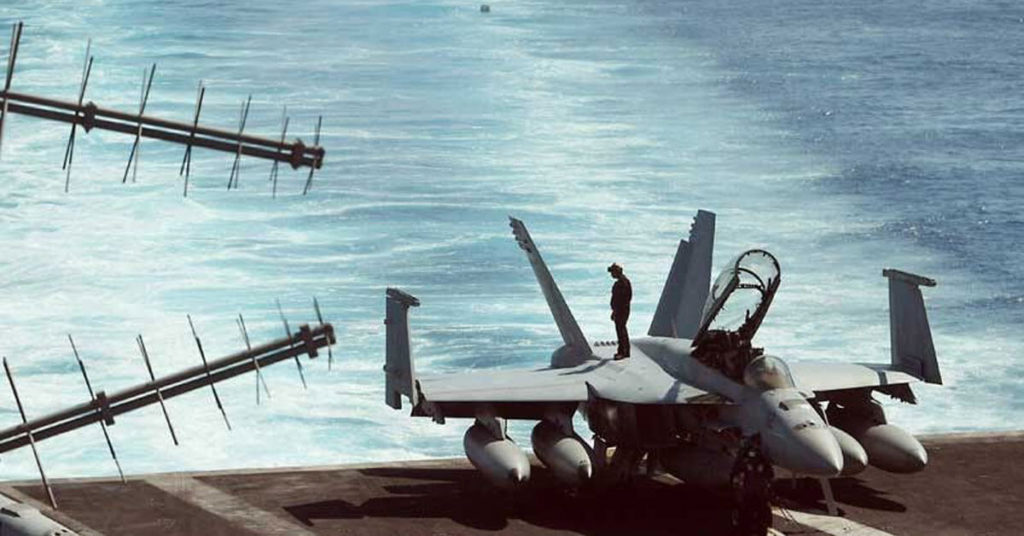MANILA, Philippines — A United States aircraft carrier displayed military power while patrolling the disputed areas in the South China Sea before docking in Manila yesterday for a scheduled port visit.
by Jaime Laude
| A sailor inspects an FA-18 Hornet fighter jet during training on the US aircraft carrier Theodore Roosevelt in the South China Sea on April 10. Top Philippine generals on board the Roosevelt were briefed by the US commander of the carrier strike group as it transited through the disputed sea on its way to the Philippines from Singapore. |
The USS Theodore Roosevelt made her presence felt at the Philippines’ mineral-rich Recto (Reed) Bank by launching an aerial demonstration. In a span of 20 minutes, 20 F-18 fighter jets took off and landed on the nuclear-powered warship.
The Theodore Roosevelt, with her embarked Carrier Air Wing (CVW) 17 and escorted by guided-missile cruiser USS Bunker Hill (CG 52), then dropped anchor at the mouth of Manila Bay.
The arrival of the US warship came before the arrival of a Japanese destroyer in Subic Bay on Friday and two Australian warships in Subic today.
The Theodore Roosevelt left its homeport in San Diego, California last Oct. 6 for a regular scheduled deployment to the US 7th and 5th Fleet theater of operations.
From Manila, the Theodore Roosevelt Carrier Strike Group (TRCSG) will be deployed to the Western Pacific with various operations, including addressing shared maritime security concerns, building relationships with partner navies and enhancing interoperability and communication with partners and allies through exercises and ship visits.
The United States is not alone in carrying out naval patrols in the strategic waterway, where Chinese, Japanese and some Southeast Asian navies operate, possibly increasing tensions and risking accidents at sea.
“We have seen Chinese ships around us,” Rear Admiral Steve Koehler, the strike group commander, told a small group of reporters on board the three-decade-old carrier.
“They are one of the navies that operate in the South China Sea, but I would tell you that we have seen nothing but professional work out of the ships we have encountered.”
“This transit in the South China Sea is nothing new in our planning cycle or in a reaction to that. It is probably by happenstance that all that is happening at the same time.”
“All of the operations that we do in and around the South China Sea or any of the bodies of water we operate in, there is a function of international law and that is ultimately what we want to recognize,” he added.
Capt. Carlos Sardiello, commanding officer of the Theodore Roosevelt, said many of the sailors and Marines aboard have strong ties to the Philippines.
“There are several rough riders who are from the Philippines or who have family in the country. We are excited for them to be able to share their culture with fellow shipmates and spend time with loved ones there,” Sardiello said.
The TRCSG’s squadrons include Strike Fighter, Marine Fighter Attack, Electronic Attack, Airborne Early Warning, Helicopter Sea Combat, Helicopter Marine Strike, Fleet Logistic Support and Destroyer.
Japan and Australia fully back the US Pacific Command’s ongoing South China Sea Freedom of Navigation Operations, all directed toward keeping the strategic sealane in the hotly disputed region open to civilian and military maritime and air navigation.
The Theodore Roosevelt’s port visit in Manila came two days ahead of the scheduled docking of Japanese destroyer JS Akizuki (DD-115) at Subic Bay on Friday.
Australian warships HMAS Anzac (FF150) and HMAS Success (OR 304) arrive at Subic Bay today.
Navies in the Western Pacific, including China and nine Southeast Asian countries, have been working on a code of unexpected encounters (CUES) at sea to avoid conflict.
The Theodore Roosevelt’s presence in the South China Sea came days after China’s massive air and naval drills in the area, in what some analysts described as an unusually large display of Beijing’s growing naval might.
China’s navy on Wednesday also released a warning on social media to other ships that they would be holding drills until Friday in the region south of Sanya city in southwest China’s Hainan province, without giving additional details.
China’s growing military presence in the waters has fuelled concern in the West about Beijing’s end game.
The United States has criticized China’s apparent militarization of manmade islands and carried out regular air and naval patrols to assert its right to freedom of navigation in stretches of a sea China claims largely as its own. – Pia Lee-Brago
Source: www.philstar.com
